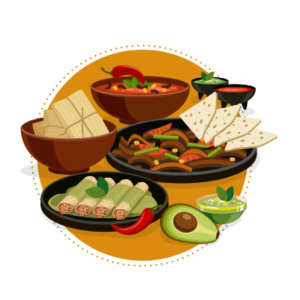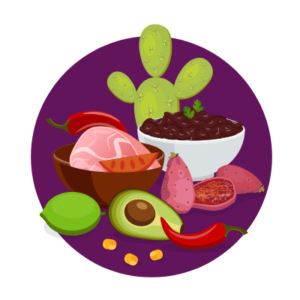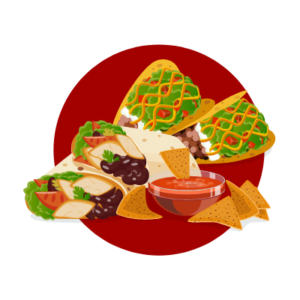Street Mexican Food: The Ultimate Guide
Are you curious about street Mexican food?
Do you want to know its origins?
Why is it an important part of Mexican culture?
Looking for the best street Mexican food?
In this ultimate guide, we’ll explore the origins, ingredients and some other curious facts and info about the beloved street Mexican food. Tacos, tamales, elotes and churros are waiting for you!
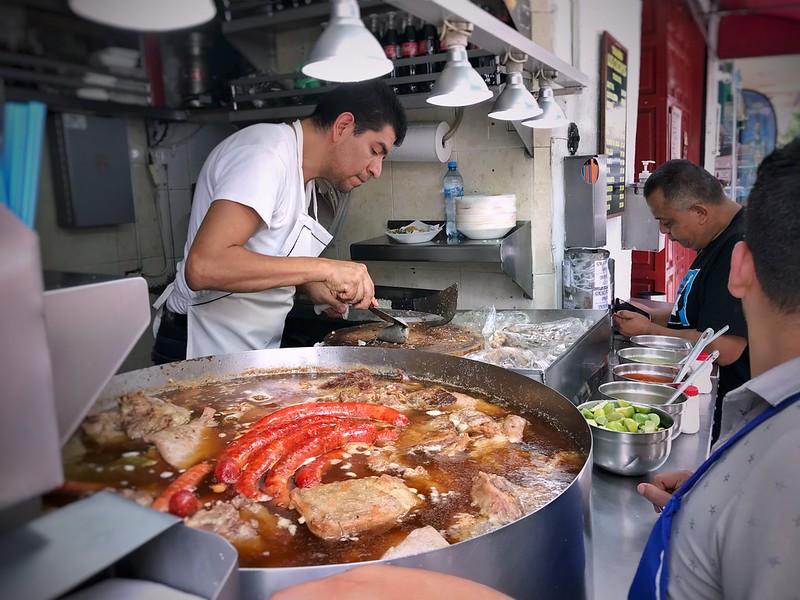
Contents
The Origins of Street Mexican Food
The rich history of street Mexican food relates deeply to Mexico’s cultural heritage. Without any doubt, the food in Mexico has centuries of tradition.
Exploring the origins of street Mexican food allows us to appreciate the food traditions that have shaped the vibrant flavors and diverse dishes we savor today.
🥑Check out our tour Mexico City Foodies Experiences (Condesa & Roma / Private or Small Group / 4h)
So, let’s delve into the fascinating origins of street Mexican food and the influences that have added to its current flavors.
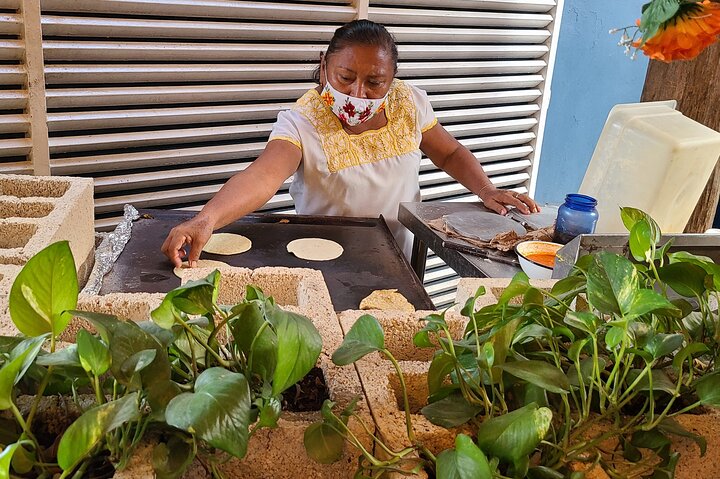
Indigenous Roots
Street Mexican food traces its roots back to the ancient Aztec, Maya, and Zapotec societies. They cultivated important crops like corn, beans, chili peppers, and tomatoes, which are still key in Mexican cooking today.
Dishes like tamales, atole (a cozy corn drink), and tlacoyos have a history linked to these early cultures and have stood the test of time, passing down through generations.
Spanish Influence
The arrival of Spanish conquistadors in the 16th century brought a fusion of flavors and ingredients to Mexican cuisine. The Spanish, for example, introduced wheat, rice, and various spices, including cinnamon, cloves, and cumin.
These new ingredients mingled with indigenous flavors, giving birth to dishes like birria (slow-cooked meat), churros (fried dough), and buñuelos (sweet fritters). Spanish techniques in food, such as frying and baking, also influenced the preparation methods of street Mexican food.
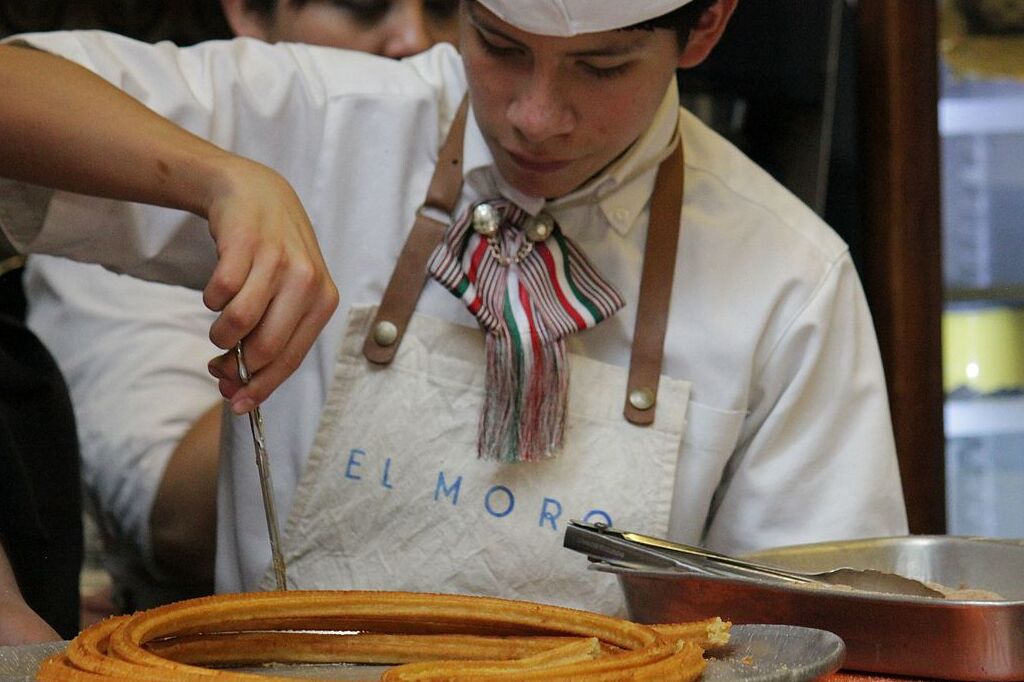
Churros at Churreria El Moro
African and Caribbean Influences
Mexico’s coastal regions, particularly along the Gulf of Mexico and the Caribbean Sea, have seen influences from African and Caribbean cultures.
In these places, adding things like bananas, coconuts, spices, and cloves changed the taste of Mexican street food. Dishes such as pescado a la Veracruzana (Veracruz-style fish) and cochinita pibil (Yucatan-style slow-roasted pork) reflect these culture-fusions.
Global Influences
Mexican street food also took in some tastes from other countries. When folks from Lebanon, China, and Italy moved in during the 1800s and 1900s, they brought their own cooking styles.
That’s why we have dishes like tacos al pastor (kind of like Lebanese shawarma), chiles rellenos (sort of from Italian stuffed peppers), and arroz chino (Mexican-style fried rice with Chinese touches).
Street Food Culture
Street Mexican food’s progress relates to the country’s street food culture. From markets to food stalls lining the streets, the accessibility and affordability of street food have made it a beloved part of everyday life in Mexico.
Thus, the art of preparing and selling street food has passed through generations, with families and communities perfecting their recipes and techniques over time.
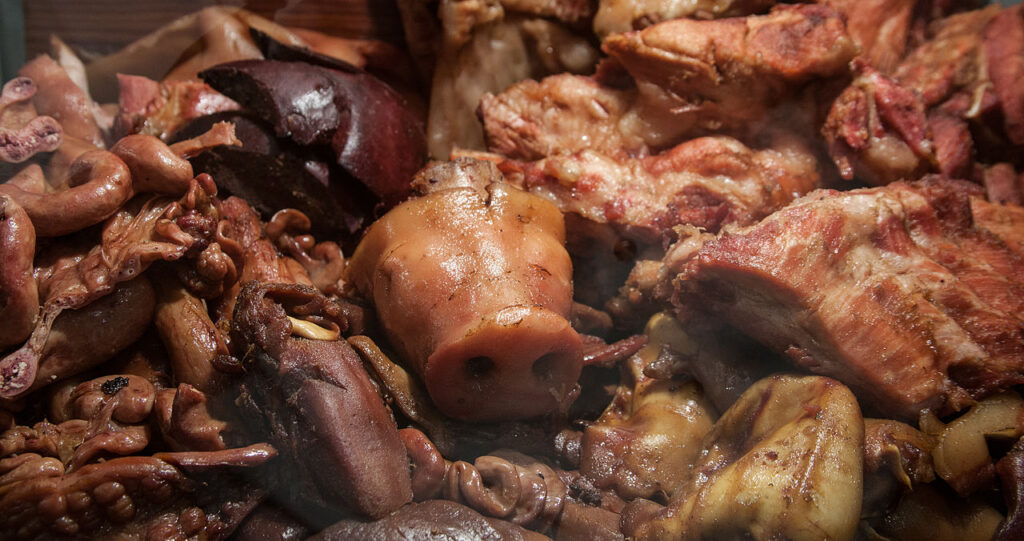
Carnitas (Pork)
Street Mexican food is a blend of indigenous, Spanish, African, Caribbean, and global influences. Together, this mixture results in a culinary mosaic that represents the country’s diverse cultural heritage. It is a way to see the resilience, creativity, and adaptability of Mexican cuisine.
When you enjoy tacos or bite into a tasty elote from a street stand, remember you’re savoring a food tradition crafted over many years of cultural history and sharing.
The Role of Street Food in Mexican Culture
Street Mexican food not only teases the taste buds but also plays a significant role in the vibrant tapestry of Mexican culture. It represents the essence of community, tradition, and food heritage. Let’s delve into the important role that street Mexican food holds in the cultural fabric of the country.
Social Gathering Spaces
Street Mexican food stalls, also known as “puestos,” act as lively social gathering spaces where locals and visitors come together to taste delicious dishes.
These busy hubs foster a sense of community, as people from all walks of life gather around shared tables, engaging in conversations, laughter, and the joy of tasting delicious food. In this place, you can make some new friends, forming bonds while indulging in plates of tacos, quesadillas, and elotes.
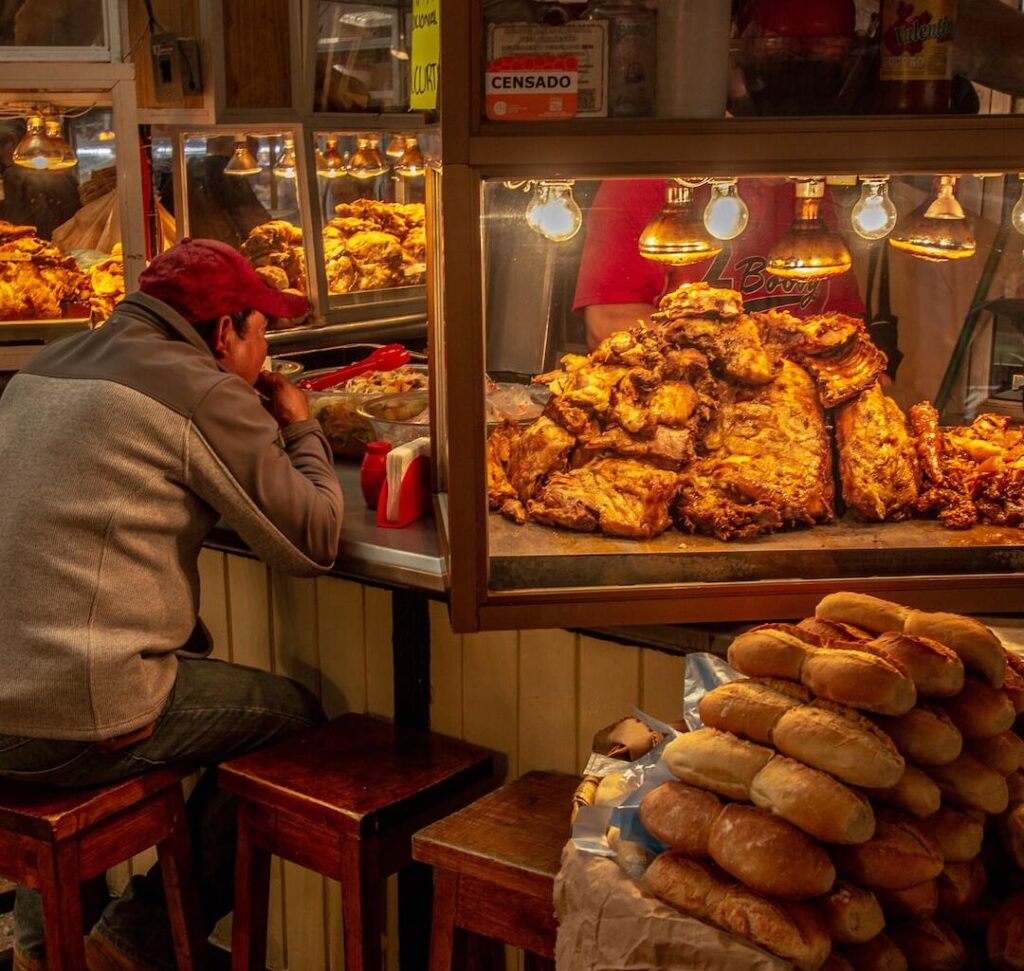
Puesto of carnitas in the market
Preserving Culinary Traditions
Culinary traditions deeply root street Mexican food passed down through generations with rich heritage and cultural importance.
From the preparation techniques to the use of traditional ingredients and spices, street food vendors uphold the authenticity and heritage of Mexican cuisine.
Whether it’s the ancient art of making tortillas by hand or the careful balance of flavors in regional specialties, street food vendors play a crucial role in preserving and promoting Mexico’s cooking traditions.
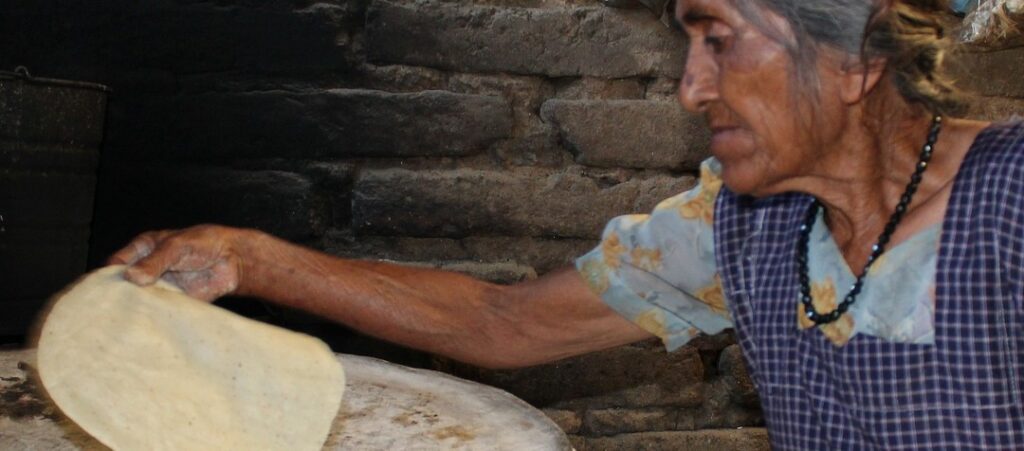
Making hand-made tortillas
Showcasing Regional Diversity
Mexico is a country of diverse regions, each with its own culinary identity. As a result, street Mexican food provides a platform for showcasing the regional diversity of flavors and ingredients.
From the fiery sauces of the Yucatan Peninsula to the complex moles of Oaxaca, street food allows travelers and locals alike to explore the unique tastes and culinary treasures of different regions.
Affordable and Accessible Cuisine
Street Mexican food is famous for its affordability and accessibility. It offers a wide range of options that cater to all budgets, making it a culinary delight for everyone.
Whether you’re a student on a tight budget or a food enthusiast seeking authentic experiences, street Mexican food provides a flavorful and satisfying meal without going bankrupt. From street tacos to tortas and tamales, these inexpensive culinary delights ensure that no one misses out on the joy of Mexican cuisine.
Cultural Identity and Pride
Street Mexican food is a source of cultural identity and pride for the country. It also embodies the spirit of Mexico’s rich gastronomic heritage and showcases the creativity, passion, and resilience of its people. Street food vendors, often operating family-owned businesses, carry the torch of tradition, infusing their dishes with love and care.
Through their culinary creations,
they celebrate Mexican culture and invite others to experience the vibrant flavors that define the country’s culinary landscape. Street Mexican food is more than just a quick and delicious meal on the go. It is a cultural institution, a source of community, and a celebration of Mexico’s culinary heritage.
From the lively puestos to the delicious aromas that fill the air, the role of street Mexican food in shaping the cultural fabric of the country is huge. So, when you savor those tasty tacos or indulge in a piping hot elote, remember that you’re not just tasting food but immersing yourself in the heart and soul of Mexico.
Top 20 Street Mexican Food Dishes
Street Mexican food is notable for its bold flavors, vibrant colors, and diverse ingredients. From tacos to elotes, there are countless options to choose from.
Tortilla-based dishes
- Tacos al Pastor. These savory tacos are exemplary street Mexican food. The «taquero» prepares thinly sliced marinated pork on a vertical spit, which brings to mind Middle Eastern shawarma. They typically serve it in warm tortillas with pineapple, cilantro, and onion.
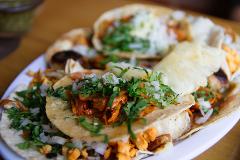
Tacos al Pastor
- Tlayudas. Directly from Oaxaca, tlayudas are large crispy tortillas with refried beans, cheese, avocado, lettuce, and your choice of meat. Some people know them as “Mexican pizzas,” these important street food treats have an incredible mixture of flavors.
- Tostadas. Those are crispy tortillas with a variety of toppings, including beans, sliced chicken or beef, lettuce, tomatoes, cheese, and salsa. The combination of textures and flavors makes them a favorite street food option.
- Quesadillas. A popular street Mexican food, quesadillas have cheese inside and often savory fillings. Those can involve meat, mushrooms, vegetables, cheese, squash blossoms, and spicy salsa. You can add some salsa, guacamole, or sour cream, they are a crowd-pleasing snack.
Other dishes from corn masa
- Sopes. These thick corn tortillas have beans, meat, lettuce, cheese, and salsa. People can fry the tortillas until they are crispy on the outside but remain soft and chewy on the inside, creating a satisfying street food dish.
- Panuchos. Hailing from the Yucatan region, panuchos are small, thick tortillas filled with refried black beans and topped with shredded chicken, pickled onions, avocado, and salsa. Local chefs then often lightly fry tortillas to create a pleasant contrast of textures.
- Tamales. These traditional Mexican delights are corn dough with various savory or sweet fillings. The most popular ones come for instance with shredded chicken, pork, cheese, or pineapple. Wrapped in corn husks and steamed to perfection, tamales are a portable and delicious street food option.
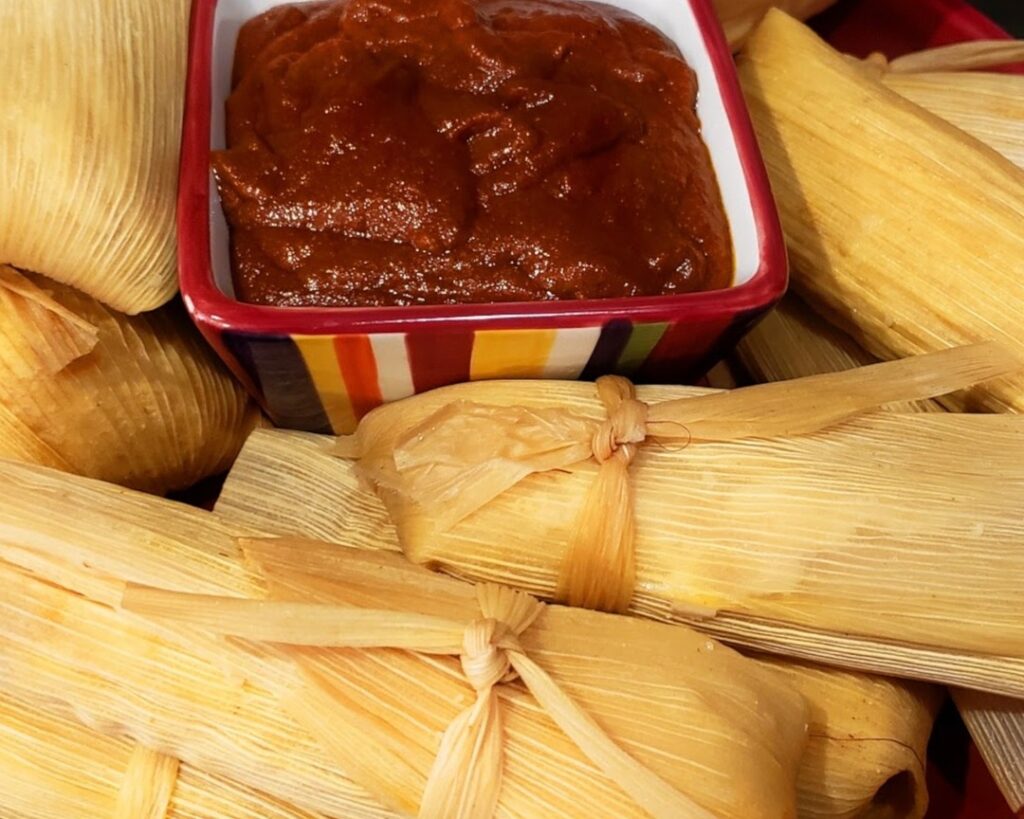
Tamales
- Gorditas. These thick cornmeal cakes are split open and people fill them with a range of delicious fillings such as meat, beans, cheese, and salsa. Then, Mexicans fry them to create an amazing street food experience.
- Tostilocos. A popular snack among locals, tostilocos are made by topping a bag of tortilla chips with diced cucumbers, jicama, peanuts, hot sauce, lime juice, and various toppings like tamarind candy or pickled pork rinds. The result is a burst of flavors and textures in every bite.
Other dishes with corn
- Elote. A beloved street food snack, elote is basically grilled corn on the cob. It’s often slathered with a creamy mixture of mayonnaise, Mexican crema, cotija cheese, chili powder, and a squeeze of lime. It’s a delightful combination of smoky, sweet, tangy, and spicy flavors.
- Esquites. Similar to elote, esquites are off-the-cob street-style corn kernels that are cooked with butter, mayonnaise, lime juice, and chili powder. Often served in cups and topped with cheese and extra seasonings, they offer a delicious twist on traditional corn.
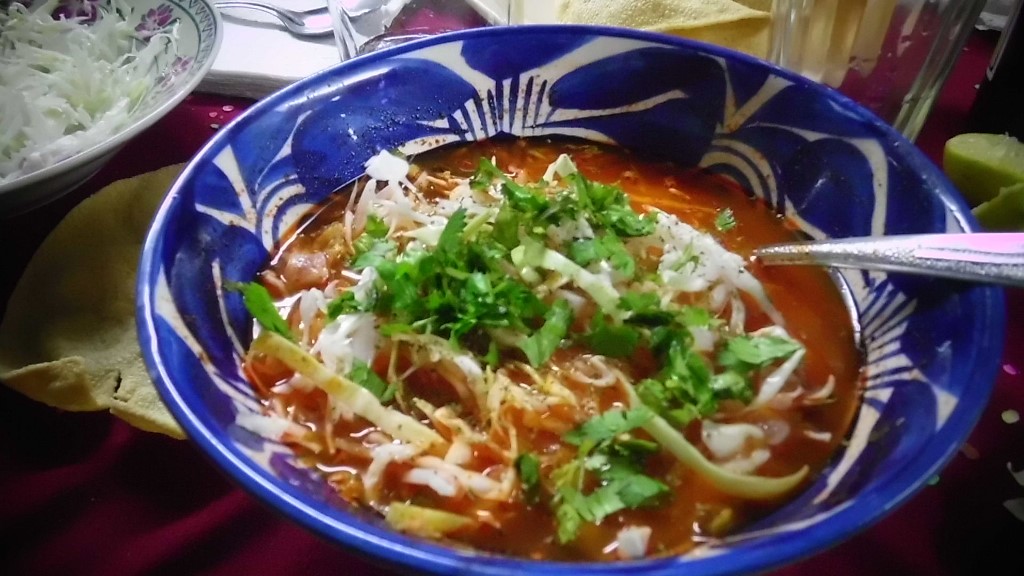
Red pozole
- Pozole. This hearty and comforting soup features hominy (dried corn kernels) cooked with meat, usually pork. Its flavorful broth is also seasoned with chili peppers, garlic, and spices and comes with fresh garnishes like shredded cabbage, radishes, onions, and lime. Pozole is a popular street food dish, particularly during celebrations.
- Marquesitas. A beloved Yucatan street dessert, marquesitas feature crispy crepes filled with Edam cheese and rolled into cones. They’re commonly topped with Nutella, condensed milk, or other sweet spreads, resulting in a delightful fusion of flavors.
Non-corn dishes
- Churros. Crispy on the outside, soft on the inside, churros are deep-fried dough pastries coated in cinnamon sugar. Served piping hot, they are perfect for a sweet experience while you walk through the streets.
- Aguas Frescas. Stay refreshed with these colorful and delicious beverages which have some fresh fruits, water, and sugar. From refreshing horchata (rice-based drink) to tamarind and sweet Jamaica (hibiscus) flavors, aguas frescas are perfect for you to try them on a hot day.
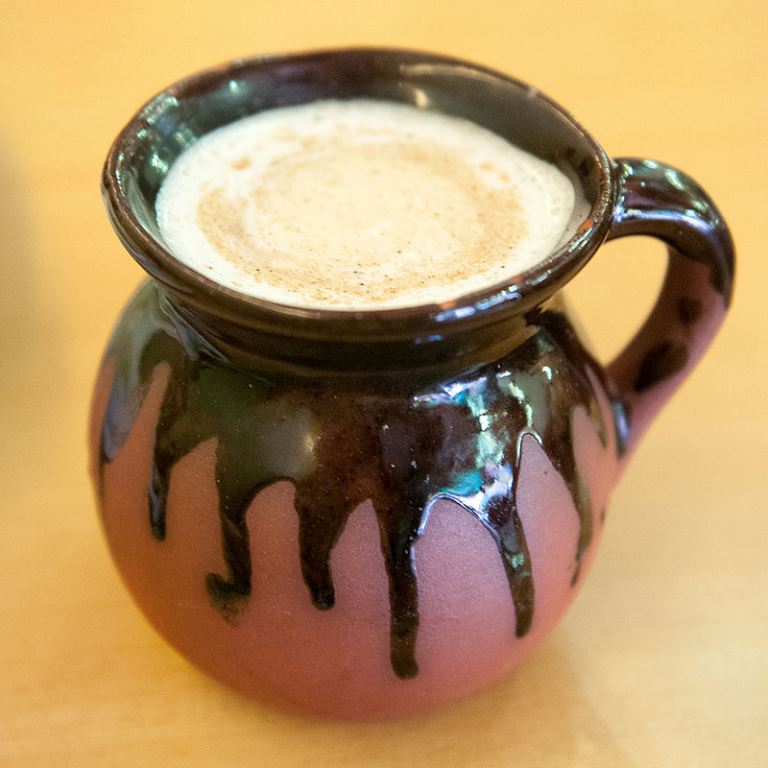
Horchata in a traditional clay cup
- Chiles Rellenos. Roasted and peeled poblano peppers are stuffed with cheese or a savory meat filling, dipped in egg batter, and then deep-fried to golden perfection. Served with a flavorful tomato sauce, chiles rellenos offer a hearty and spicy street food option.
- Molletes. These open-faced sandwiches consist of bolillo bread with different toppings. Those may include refried beans, and melted cheese, and often go together with salsa, pico de gallo, or avocado. Molletes are a popular street food breakfast option that provides a hearty start to the day.
- Camotes. Sweet potatoes are roasted in traditional clay ovens until caramelized and tender. Sprinkled with cinnamon, sugar, and a drizzle of condensed milk, camotes offer a deliciously sweet street food treat.
- Birria. Originating in Jalisco, birria is a savory stew made with tender, slow-cooked meat (often goat or beef) marinated in a rich blend of spices and chili peppers. Served in tacos, tortas, or on its own, birria is a flavorful and satisfying street food choice.
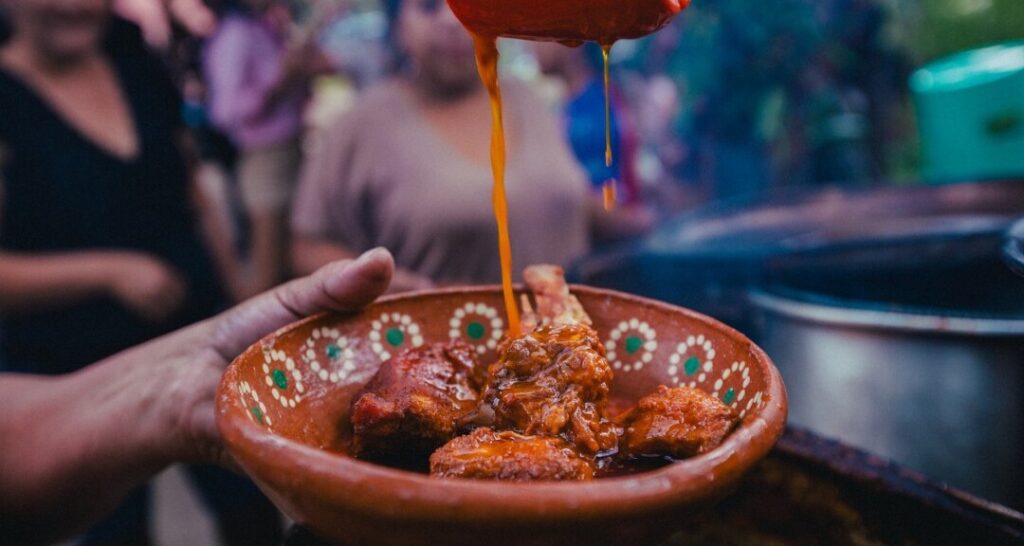
Birria
- Ceviche. Ceviche is a zesty seafood dish made with raw fish or shrimp marinated in citrus juices and mixed with onions, tomatoes, cilantro, and chili peppers. The acid from the citrus juices “cooks” the fish, resulting in a tangy and vibrant street food delight.
Regional Variations in Street Mexican Food
Street Mexican food is a culinary treasure trove that showcases the diverse flavors and regional specialties of the country. Each region boasts its own unique street food creations, adding a delightful twist to the vibrant tapestry of Mexican cuisine. Let’s explore some of the regional variations in street Mexican food that will surely tantalize your taste buds.
Mexico City
As the bustling capital, Mexico City offers an array of street food delights.
🌽Check out our tour Street Food Tour Mexico City (Downtown / 4h)
Here, you’ll find the iconic quesadillas, where blue corn tortillas are stuffed with huitlacoche (corn fungus), squash blossoms, or tinga (spicy shredded chicken). Don’t miss the legendary street snack, tlacoyos – thick tortillas topped with beans, cheese, and your choice of filling.
Oaxaca
Known as the culinary capital of Mexico, Oaxaca is a haven for food lovers.
🍄Check out our tour Oaxaca Food Tour (Monte Alban, Miahuatlan, Huatulco / Private or Small Group / 10 Days)
Sample the irresistible tlayudas, oversized crispy tortillas topped with a myriad of ingredients like asiento (pork lard), beans, tasajo (thinly sliced beef), and the region’s famous stringy cheese, quesillo. Don’t miss out on the savory tamales wrapped in banana leaves and filled with unique ingredients like mole or chapulines (crunchy grasshoppers).
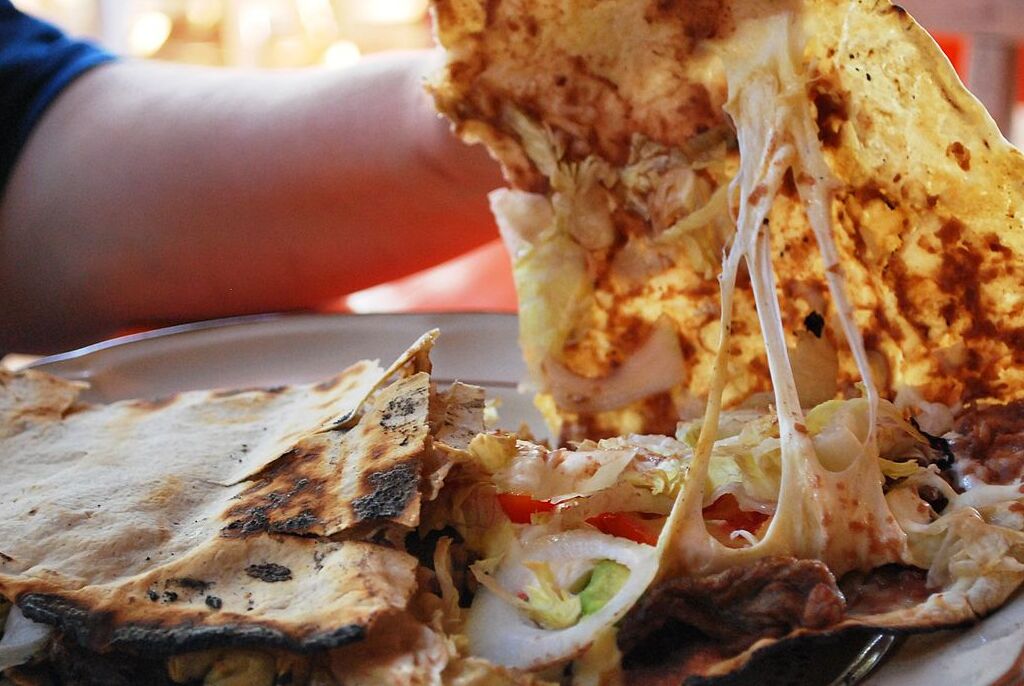
Tlayuda
Jalisco
A vibrant region in western Mexico, Jalisco is famous for its rich and diverse cuisine. From the famous birria stew, made with tender and flavorful meat, to the iconic torta ahogada, a drowned sandwich bursting with spicy goodness, Jalisco’s food is a true delight. What about trying a “birriamen”? Ramen with birria?! Come to the surrealistic world of Mexican food, and taste its creative and unique cuisine!
The hearty carne en su jugo, a beef soup cooked in its own juices, provides a comforting and satisfying dining experience. Don’t forget to try the refreshing tejuino, a traditional fermented corn drink that offers a unique and tangy flavor. And, of course, no visit to Jalisco is complete without savoring the exquisite flavors of tequila, a renowned spirit deeply rooted in the region’s culture.
Yucatan Peninsula
The Yucatan region is celebrated for its distinctive Mayan flavors and influences. Try cochinita pibil, a succulent dish made from slow-roasted marinated pork, traditionally cooked in an underground pit.
🥬Check out our tour Merida Food Tour (in Markets & Cantinas / Group / 4h)
Savor the flavors of papadzules, rolled tortillas filled with boiled eggs and bathed in a rich pumpkin seed sauce. For dessert, indulge in marquesitas, crispy crepes filled with Dutch cheese and sweet toppings like Nutella or caramel.
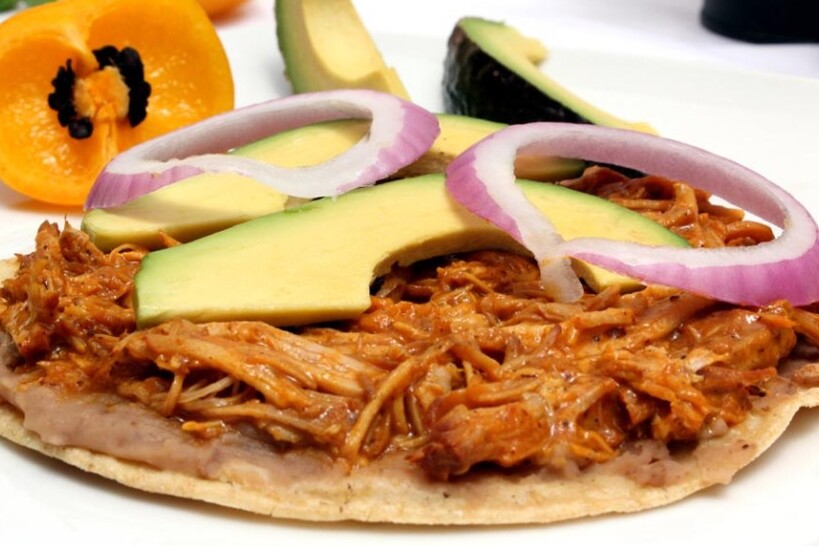
Tacos de cochinita pibil
Baja California
Located on the peninsula’s northern edge, Baja California is renowned for its seafood delicacies.
Sample the iconic fish tacos, where fresh catch of the day is battered, deep-fried, and served in a soft tortilla with cabbage, creamy sauce, and a squeeze of lime. Also, keep an eye out for mouthwatering ceviche tostadas, featuring tangy marinated seafood piled on crispy tortillas.
Puebla
Puebla, known for its rich culinary heritage, offers delightful street food options. Bite into the flavorful cemita, a regional sandwich filled with breaded meat, avocado, Oaxacan cheese, chipotle peppers, and papal (a local herb).
🥔 Check out our tour Puebla Food & Flavors (Cholula, Atlixco / Private or Small Group / 3 Days)
For a sweet treat, try the renowned chiles en nogada, roasted poblano peppers stuffed with a savory-sweet mixture of meat, fruits, and nuts, topped with a creamy walnut sauce and pomegranate seeds.
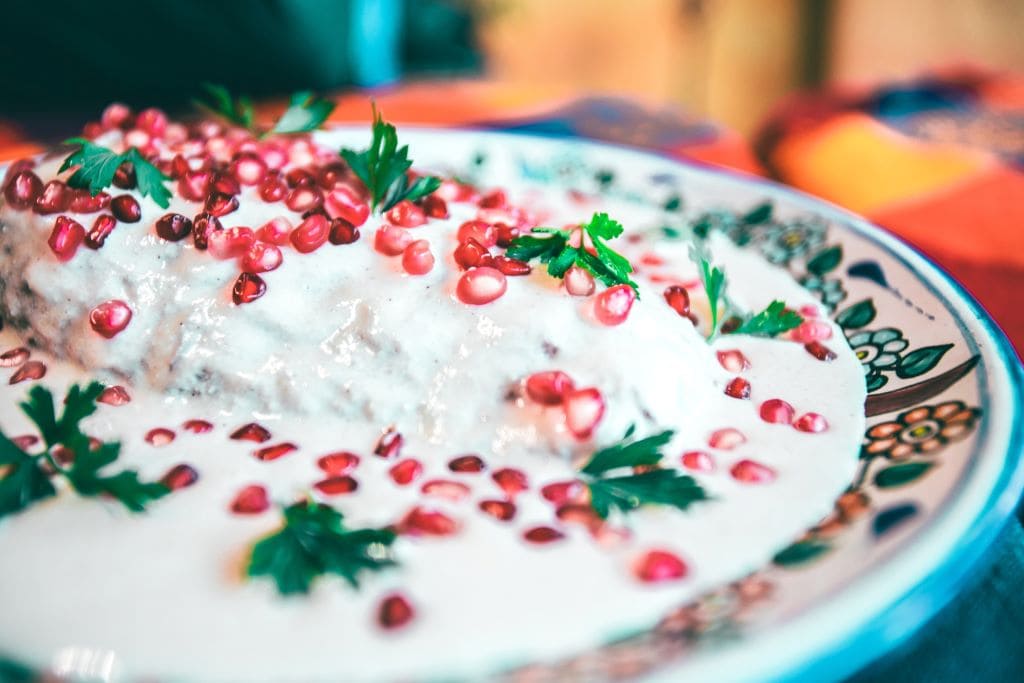
Chiles en nogada
These are just a few examples of the diverse regional variations you can find in street Mexican food.
🌮Check out our tour Mexico Food Tour (Tlaxcala & Puebla / Private / 14h)
Whether you’re exploring the Mexico City streets, savoring the flavors of Oaxaca, indulging in the Yucatan’s culinary delights, relishing Baja California’s seafood offerings, or experiencing the traditional tastes of Puebla, each region’s street food scene provides a captivating culinary journey.
How to Make Authentic Street Mexican Food at Home
Craving the vibrant flavors of street Mexican food but can’t hop on a plane to indulge? Don’t worry! With a few key ingredients and some culinary know-how, you can recreate the authentic flavors of street Mexican food right in your own kitchen. Let’s explore some tips and techniques to help you master the art of making street Mexican food at home.
Embrace Fresh and Authentic Ingredients
One of the cornerstones of street Mexican food is the use of fresh, high-quality ingredients. Seek out authentic Mexican ingredients like corn tortillas, dried chili peppers, fresh cilantro, lime, and queso fresco (fresh cheese) to capture the true essence of Mexican flavors. These ingredients are widely available in Mexican grocery stores or one can also get them online.
Master the Art of Salsas and Sauces
Salsas and sauces are the flavor-packed heroes of street Mexican food. Learn to make classic salsas like salsa verde (made with tomatillos and green chilies) or salsa roja (made with tomatoes and red chilies).
Experiment with different chili peppers to achieve your desired level of heat and flavor. Don’t forget to include tangy lime juice, aromatic herbs, and a pinch of salt to elevate your salsas to the next level.
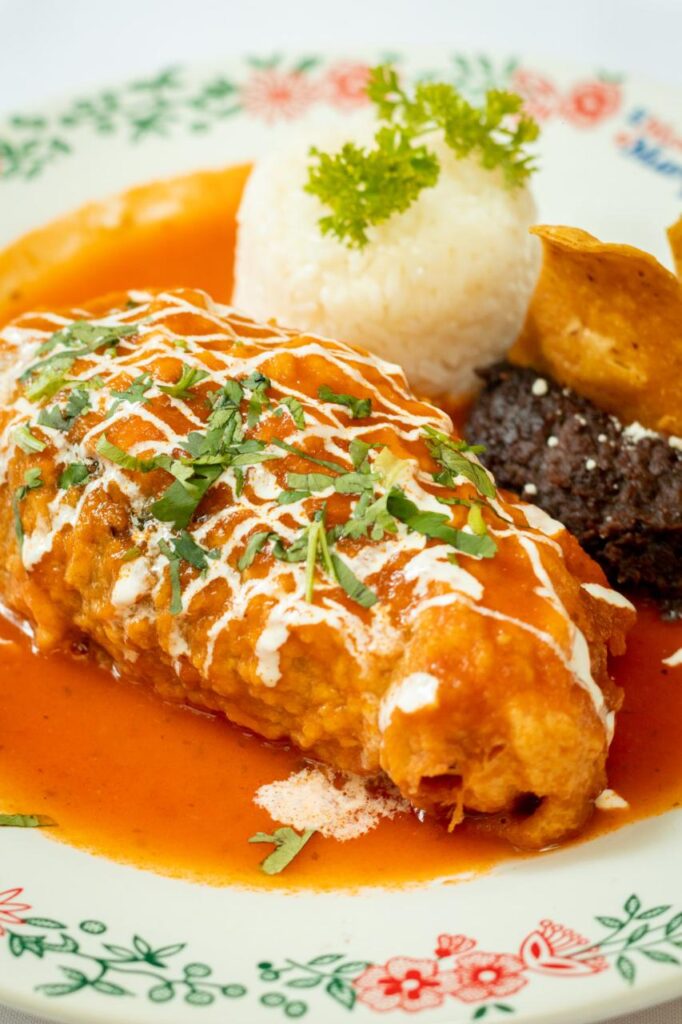
Chile relleno in salsa roja
Explore the World of Marinades and Rubs
Many street Mexican food favorites, such as carne asada (grilled steak) and al pastor (marinated pork), rely on flavorful marinades and rubs.
Experiment with traditional marinades that combine ingredients like citrus juices, garlic, onion, spices, and herbs to infuse your meats with authentic Mexican flavors. Allow the meats to marinate for at least a few hours or overnight for maximum flavor infusion.
Master the Art of Tortilla Making
Corn tortillas are the foundation of many street Mexican food dishes. While store-bought tortillas are convenient, making your own from scratch takes your culinary adventure to another level. Get your hands on masa harina (corn flour) and follow traditional recipes to create fresh, soft, and pliable tortillas that are the perfect vehicle for your favorite fillings.
Experiment with Fillings and Toppings
Street Mexican food offers a wide range of fillings and toppings to tantalize your taste buds. From succulent grilled meats and tender braised stews to vegetarian options like grilled cactus or sautéed mushrooms, the possibilities are endless. Add yummy toppings like chopped onions, fresh cilantro, crumbled cheese, and a squeeze of lime to enhance the flavors and textures of your creations.
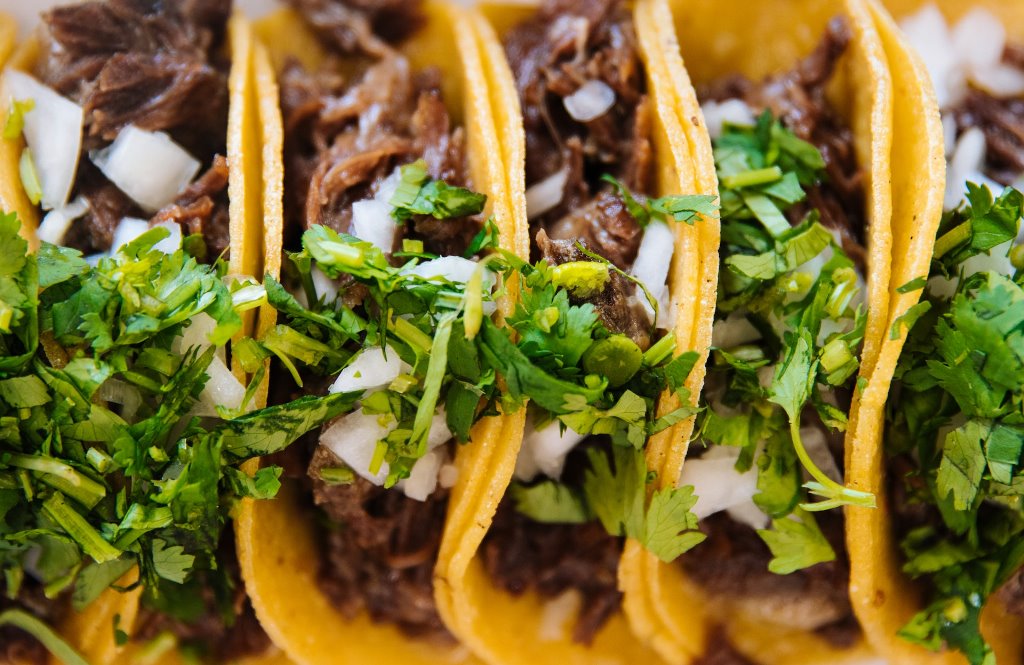
Tacos with topped with cilantro
Don’t Forget the Side Dishes
Street Mexican food is often accompanied by delicious side dishes that complement the main attractions.
Whip up some traditional favorites like frijoles refritos (refried beans), Mexican rice, or spicy pickled vegetables to complete your homemade street food feast.
Enjoy the Experience
With these tips, you can bring the spirit of street Mexican food right into your kitchen. Get your ingredients, let your creativity shine, and start your tasty adventure into the world of street Mexican food.
It’s a lively and tasty cuisine that’s gaining more fans lately. From Mexico City streets to food trucks worldwide, these dishes showcase the country’s incredible history and culture.
Conclusion
Street Mexican food isn’t just about the taste; it’s an experience. Make a fun table, play Mexican tunes, and enjoy with family and friends for that lively vibe. Enjoy the relaxed feel of street food and relish every bite.
So, which street Mexican food would you love to try? Any other dishes you think should be on the list? Once you try street Mexican food, you’ll discover your inner foodie!
¡Buen provecho!
- Tell us in the comment section which street Mexican food you have already tried. Which one was missing?
- Share your comments with other foodie lovers like you!



